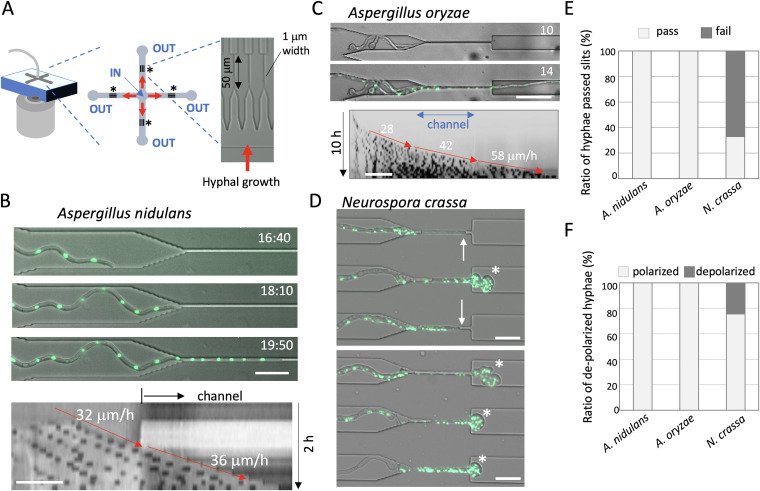FIG 1.
A. nidulans and A. oryzae but not N. crassa hyphae pass through the channels. (A) Design of the microfluidic device, with inflow at the center (IN) and outflows at the four path ends (OUT). Twenty microchannels of 1 μm width and 50 μm length were included between the inlet and outlet for each arm (asterisks) of the cross-shaped design. (B, upper) Time series showing a hypha of A. nidulans (nuclei labeled with GFP) growing into the channel. The elapsed time is given in hours:minutes. (B, lower) Kymograph along the growth axis before and in the channel (from Movie S1 in the supplemental material). The hyphal elongation rates before and in the channel are shown by arrows. Total 2 h; scale bar 20 μm. (C, upper) Time series showing a hypha of A. oryzae (nuclei labeled with GFP) passing through the channel. The elapsed time is given in hours. (C, lower) Kymograph along the growth axis before, in, and after the channel (from Movie S2). Total 10 h; scale bar 20 μm. (D) Images of N. crassa (nuclei labeled with GFP) hyphae that have stopped growing in the channels (arrows) and depolarized hyphae exiting from the channels (asterisks) (from Movie S3). Scale bar 20 μm. (E) Ratio of the hyphae that successfully passed through the channels (pass) or stopped in or exiting from the channels (fail) in A. nidulans, A. oryzae, and N. crassa; n = 50 for each. (F) Ratio of polarized or depolarized hyphae that passed through the channels in A. nidulans, A. oryzae, and N. crassa; n = 50 for each.

